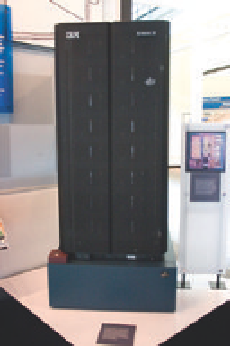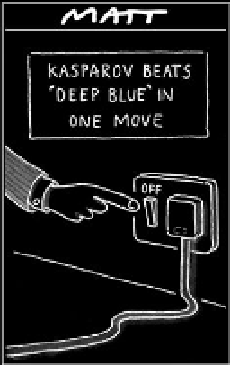Information Technology Reference
In-Depth Information
world computer chess championship in 1980. The U.S. Department of State
temporarily confiscated Belle in 1982 as it was heading to the Soviet Union to
participate in a computer chess tournament. The State Department claimed it
was a violation of U.S. technology transfer law to ship a high-technology com-
puter to a foreign country. The next prize of $10,000 for the first program to
achieve an Elo rating of 2500 was awarded to a computer called Deep Thought
in August 1989. Deep Thought was a computer specifically designed to play
chess by Feng-hsiung Hsu and his fellow graduate student Murray Campbell at
Carnegie Mellon University. IBM then recruited Hsu and Campbell to develop a
successor to Deep Thought. The result was Deep Blue, a parallel computer with
thirty processors, enhanced by 480 special-purpose chess chips (
Fig. 13.11
).
Deep Blue was capable of evaluating two hundred million positions a second
and could typically search six to eight moves ahead, and sometimes more. A
team of three chess grand masters provided its opening library, and its end-
game database included many six-piece endgames as well as those with five
pieces and fewer. In May 1997, world champion Garry Kasparov took on Deep
Blue in a six-game match held in New York (
Fig. 13.12
). The computer won a
close match with two wins for Deep Blue, one for Kasparov, and three draws.
The $100,000 Fredkin Prize went to Feng-hsiung Hsu, Murray Campbell, and
Joseph Hone from IBM. After the match, Kasparov wrote:
Fig. 13.11. IBM's Deep Blue chess com-
puter first played Kasparov in 1996.
On that occasion the world champion
managed to beat the machine. Kasparov
famously lost the rematch a year later.
The decisive game of the match was Game 2, which left a scar in my
memory … we saw something that went well beyond our wildest expectations
of how well a computer would be able to foresee the long-term positional
consequences of its decisions. The machine refused to move to a position that
had a decisive short-term advantage - showing a very human sense of danger.
16
Neural networks
In the audience for Norbert Weiner's neurophysiology talk in 1942 was
Warren McCulloch (
B.13.8
), a professor of psychiatry in Chicago. With a pre-
cocious eighteen-year-old mathematician called Walter Pitts, McCulloch devel-
oped the first model of the brain as an electrical network of interconnected
neurons. They argued that their idealized “neural network” model captured
the key features of the brain's physiology. Von Neumann was so impressed by
this work that, together with Wiener and Howard Aiken from Harvard, he orga-
nized a small workshop at Princeton in January 1945 at which McCulloch and
Pitts were invited to present their neural network model. Ideas from neural
networks were fresh in von Neumann's mind when he wrote his “Draft Report
on the EDVAC” later that year - in which he referred to the basic functional
units of the computer as “organs” and made comparisons of the functions of
these units with the biological functions of neurons.
The importance of the brain in determining human emotions was rec-
ognized by Hippocrates, the “Father of Medicine,” as long ago as 400
B.C.
He
said, “Men ought to know that from nothing else but the brain come joys,
delights, laughter and sports, and sorrows, griefs, despondency, and lamenta-
tions.”
17
The human brain has a similar structure to brains of other mammals
but is significantly larger in relation to body size compared to most animals. The
relative increase in size of the human brain is mainly due to the greater size of
Fig. 13.12. The newspapers and other
media portrayed the 1997 match
between World Chess Champion Garry
Kasparov and IBM's Deep Blue computer
as a battle between human and machine.
The cover of
Newsweek
proclaimed it “The
Brain's Last Stand.”


Search WWH ::

Custom Search